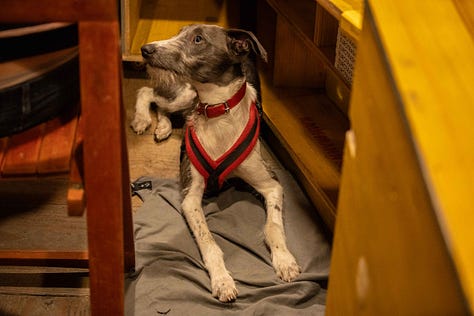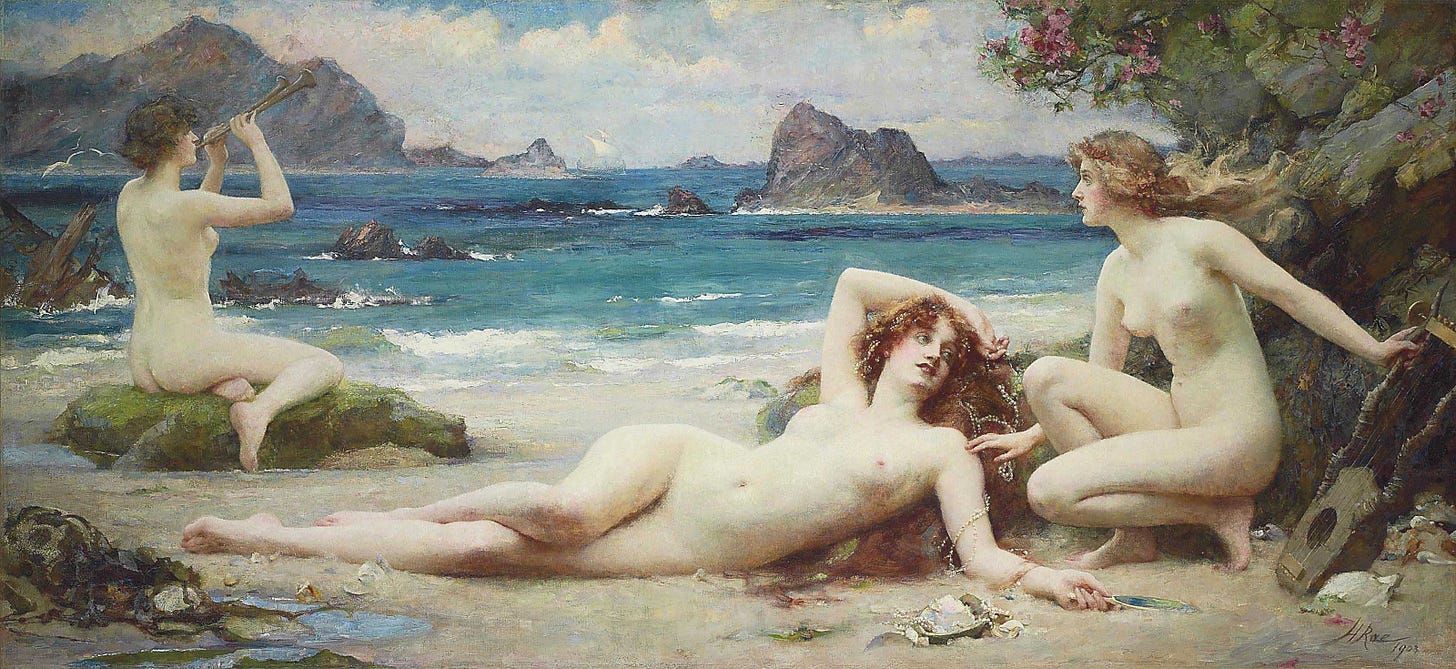Bare-breasted bird women and a whole lot of beeswax
Odysseus and the Sirens (specifically their weirdly sexual glow-up in art)
Before we get into one of my favourite parts of my all time FAVOURITE myth (you get minimal points for guessing as it’s literally my username), I hosted my FIRST EVER IN-PERSON SUBSTACK EVENT LAST WEEK AND IT WAS SO WONDERFUL HERE ARE SOME PICS.









The venue was gorgeous, guests were so friendly and engaged (and my partner was a fab bartender) but our panelists knocked it out of the PARK. A moment for
, , and (especially Ann and Holly who’d never met me let alone attended one of my events ~ thank you for trusting a complete stranger emerging from the depths of the internet). Their answers were thoughtful and honest and I learnt a LOT. Highlights that have lodged themselves in my mind are Honor’s point that ancient historical writings are closer to our modern conceptualisation of historical fiction (more focussed on storytelling than accuracy), Ann’s rather horrifying factoid that once a woman was married to a Cambridge professor she had to attend a very fancy dinner IN her wedding dress and Holly’s wildly impressive ability to schedule her posts months and MONTHS in advance. (Also a book fell off one of the shelves and whacked Honor in the head right at the beginning of the panel discussion and I’d be lying if I said that moment has not emblazoned itself on my memory). Thank you to all three of you and thank you to everyone that came along for such a sensational evening.Now onto the MYTH. I will be gobsmacked if you haven’t heard of Odysseus and the Sirens or at least heard the phrase siren-song so I’m not going to waste TOO much time on a recap. More like a little refresh.
Homer’s Odyssey is a long and winding tale that recounts Odysseus’ perilous journey home from Troy. There are MANY perils (it took him ten years to get back to Ithaca), but for this newsletter we are focussing on one peril in particular, the glorious bird-women with excellent singing skills known as the Sirens.
Circe, the transformative witch-goddess, warns Odysseus exactly what he’s going to come up against; how the Sirens will lure him and his crew with their lovely voices and then gobble them up as soon as they reach their island. So this is one RARE instance where they’re actually prepared. Odysseus instructs his crew to plug up their ears with beeswax to block out the sound and tie him to the mast so he can hear their siren-song. A bold choice but in this case curiosity does NOT kill the cat. By nothing short of a miracle (the miracle, in this case, is Circe’s advice), Odysseus and his men actually manage to sail by unscathed. There’s one other moment in myth where a bunch of sailors pull this off—Orpheus is on board and plays the lyre super loudly, drowning out the Sirens—but this is still a huge and quite surprising victory.
I’ve included a short clip of me explaining this part from the Odyssey in a Day, a recap of Homer’s Odyssey I shot in Corfu a while back (tying that knot took 5+ takes, I wish I was exaggerating).
If you skipped the video, the one point I make there which I haven’t mentioned yet is that after Odysseus and his men sail by, the Sirens are so devastated by their failure/lack of supper, they fling themselves into the ocean and drown. It’s always struck me as a rather disproportionate response and, frankly, a weird detail. But here we are.
I’m not going to get too bogged down in the weeds of the deeper meanings of the Odyssey and what the various trials such as the Sirens may symbolise—I am determined to keep this newsletter about ART—but I AM going to include a quote I cam across recently in The Distaff Side, edited by Beth Cohen (I ordered a secondhand copy online and I think I now possess a stolen library book):
“[The many episodes of the Odyssey] constitute a series of diverse, wide-ranging stories about the pleasures and dangers of human existence, stories that tend to represent what is “human” as male and most of the “pleasures” and “dangers”—or what a male imagination fantasizes as such—as female.” — Seth L. Schein, p. 19.
A great quote which we can tear apart at a later date (please note Schein’s use of “most” because I can feel you asking what about Polyphemus).
Now how did the Greeks visualise the Sirens?
This stamnos depicts these glorious creatures as essentially large pigeons with the heads of human females.

This sweet little South-Italian askos comes from the fifth century BCE and shows a slightly more detailed version of what we see on the stamnos (and this one is holding a pomegranate!!!).
This amphora predates the other two examples by about 100 years but it’s still very pigeon-like. So this style of Siren is all the rage in 500/400 BCE but then something shifts.
What do we have here???? A Siren????? With her boobs out???? Looking semi-human??? This statue, dating from 390 BCE, is one of many examples that show the anthropomorphising (spellcheck had a field day with that one) of Sirens in ancient art.
Modern art, however, takes this process to another level. The fearsome, deadly Sirens get all H20 Just Add Water.
Cleo naur!!!!!!!!!!! (I’m Australian, it’s fine).
Okay at least here we’ve got some rotting corpses. That’s something.
Waterhouse, you can stay. Your Sirens look weird as hell.
I mean come ON. Not a single feather???????
There are dozens of other examples but I’ve already received the “Post too long for email” warning from Substack 3 times so I hope these depictions have made my point.
The whole turning frightening female monsters into sexual objects for the male gaze thing is somewhat slapping us in the face here.
So my question to you is, am I the only one that misses or prefers their original, pigeon-heavy form?
If you’ve made it this far, thank you <3 and please enjoy this harrowing photo I took at the Odysseus-themed theme park in Kefalonia (it’s real, look it up).
I have so many questions. And they’re mostly about the length and colour of their tails.














the theme park LMAO I simply must visit
ohmygoodness this is brilliant! I love how you make the past so exquisitely present. And the depictions of sirens before they became anthropomorphised - wow. Loads to ponder here & maybe a bit of rage, or… a lot? So much to think about when it comes to depictions of female/ feminine power and how that translates in a wider way